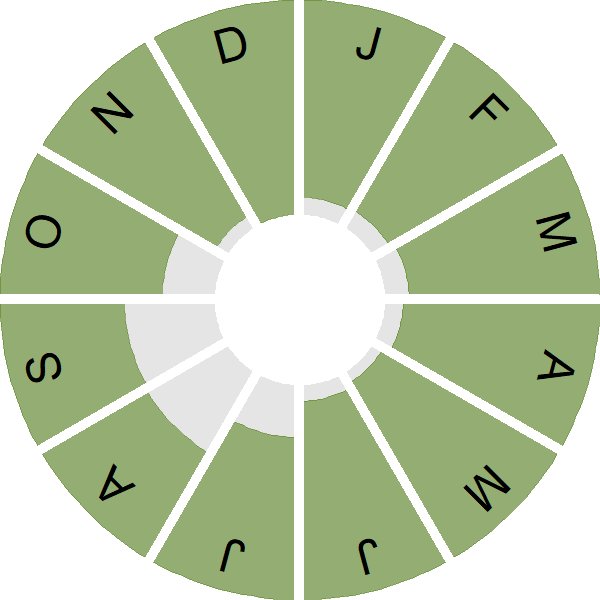Blackbird
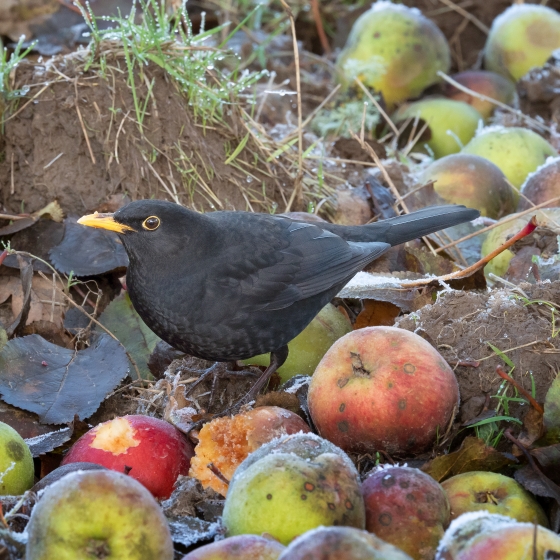
Introduction
The Blackbird is one of our most common and familiar birds. It is particularly numerous in gardens, but can be found almost everywhere in Britain & Ireland, apart from the highest ground.
This species forages on the ground, and is most often seen turning over leaf litter, probing the soil for food, or visiting flat feeders like bird tables. Adult male birds are black with a contrasting yellow bill and eyering, whilst females are browner and streakier. The Blackbird's fluting, melodic song, often performed from a high perch, is a particular feature of summer evenings.
Breeding numbers have increased in the UK since the mid-1990s, but more recently have declined sharply in London and surrounding areas. The UK also hosts many additional birds from northern Europe in the winter.
- Our Trends Explorer gives you the latest insight into how this species' population is changing.

Key Stats
Identification
ID Videos
This section features BTO training videos headlining this species, or featuring it as a potential confusion species.
#BirdSongBasics: Robin and Blackbird
#BirdSongBasics: Blackbird and Song Thrush
Nightingale and Other Night Singers
Ring Ouzel and Blackbird
Songs and Calls
Song:
Call:
Alarm call:
Flight call:
Status and Trends
Conservation Status
Population Change
Both CBC/BBS and CES data show long-term declines in Blackbird abundance up to about the mid 1990s followed by a strong but partial recovery, which currently has stalled. The BBS map of change in relative density between 1994-96 and 2007-09 indicates that increase over that period occurred mainly in high-rainfall parts of the country, particularly Wales, northwestern England and southern Scotland. More recent BBS data suggest that this remains the case: they show a significant decline in London since 1995, stability in the South-east, East and North-east English regions, but increasing populations in the other five English governmental regions and in Northern Ireland, Scotland and Wales (Harris et al. 2020). The moderate-decline criterion for amber listing is no longer met, and the species has been listed in the green category since 2002.
There has been an increase across Europe since 1980 (PECBMS: PECBMS 2020a>).
Distribution
Blackbirds are among the commonest birds in Britain & Ireland, with records from 96% of 10-km squares in both the winter and the breeding season; it is absent only from a few upland and remote island 10-km squares. High densities in the east and midlands of Ireland and the lowlands of England and Wales contrast with low densities in the uplands of northern England, Scotland, Wales and western Ireland.
Occupied 10-km squares in UK
2007/08–10/11
or view it on Bird Atlas Mapstore.
2008–11
or view it on Bird Atlas Mapstore.
European Distribution Map
Distribution Change
Although there has been little overall change in range size, abundance within the range has increased, particularly in square in parts of Wales and Scotland.
Change in occupied 10-km squares in the UK
from 1981–84 to 2007–11
or view it on Bird Atlas Mapstore.
from 1968–72 to 2008–11
or view it on Bird Atlas Mapstore.
Seasonality
Blackbird is a common and widely recorded species, encountered on over 60% of complete lists in most months.
Weekly pattern of occurrence
The graph shows when the species is present in the UK, with taller bars indicating a higher likelihood of encountering the species in appropriate regions and habitats.

Habitats
Breeding season habitats
Relative frequency by habitat
The graph shows the habitats occupied in the breeding season, with the most utilised habitats shown at the top. Bars of similar size indicate the species is equally likely to be recorded in those habitats.
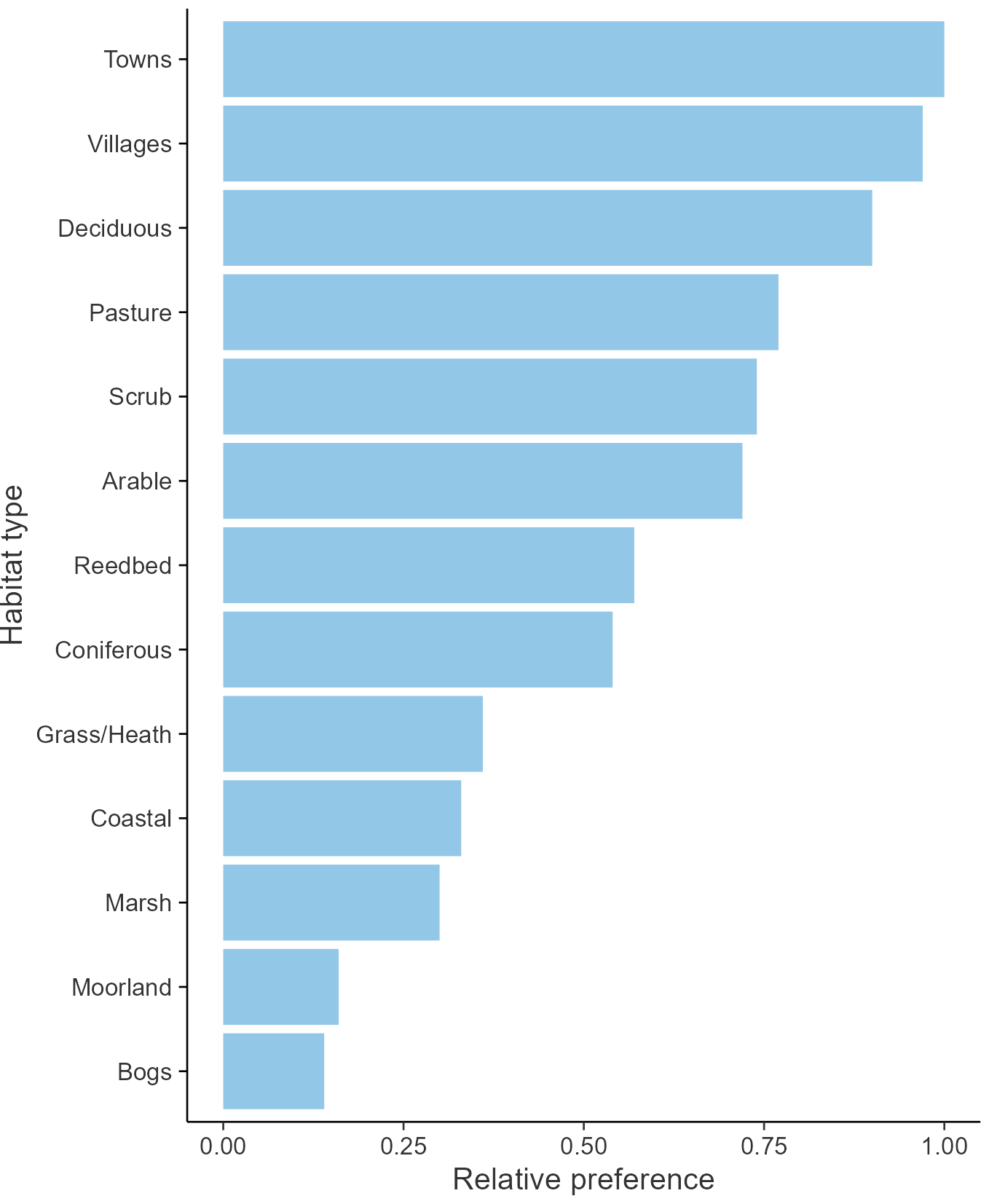
Movement
Britain & Ireland movement
Foreign locations of birds ringed or recovered in Britain & Ireland
Dots show the foreign destinations of birds ringed in Britain & Ireland, and the origins of birds ringed overseas that were subsequently recaptured, resighted or found dead in Britain & Ireland. Dot colours indicate the time of year that the species was present at the location.
- Winter (Nov-Feb)
- Spring (Mar-Apr)
- Summer (May-Jul)
- Autumn (Aug-Oct)

European movements
EuroBirdPortal uses birdwatcher's records, such as those logged in BirdTrack to map the flows of birds as they arrive and depart Europe. See maps for this species here.
The Eurasian-African Migration Atlas shows movements of individual birds ringed or recovered in Europe. See maps for this species here.
Biology
Productivity and Nesting
Nesting timing
Egg measurements
Clutch Size
Incubation
Fledging
Survival and Longevity
Survival is shown as the proportion of birds surviving from one year to the next and is derived from bird ringing data. It can also be used to estimate how long birds typically live.
View number ringed each year in the Online Ringing Report.
Lifespan
Survival of adults
Survival of juveniles
Biometrics
Wing length and body weights are from live birds (source).
Wing length
Body weight
Ring Size
Classification, names and codes
Classification and Codes
- Order: Passeriformes
- Family: Turdidae
- Scientific name: Turdus merula
- Authority: Linnaeus, 1758
- BTO 2-letter code: B.
- BTO 5-letter code: BLABI
- Euring code number: 11870
Alternate species names
- Catalan: merla
- Czech: kos cerný
- Danish: Solsort
- Dutch: Merel
- Estonian: musträstas
- Finnish: mustarastas
- French: Merle noir
- Gaelic: Lòn-dubh
- German: Amsel
- Hungarian: fekete rigó
- Icelandic: Svartþröstur
- Irish: Lon Dubh
- Italian: Merlo
- Latvian: melnais mežastrazds
- Lithuanian: juodasis strazdas
- Norwegian: Svarttrost
- Polish: kos
- Portuguese: melro
- Slovak: drozd cierny
- Slovenian: kos
- Spanish: Mirlo común
- Swedish: koltrast
- Welsh: Mwyalchen
Research
Causes of Change and Solutions
Causes of change
The causes of change are generally uncertain although changes in survival are likely to be important. Recent declines in south-east England have been caused by the establishment of the mosquito-borne Usutu virus, which has reduced survival in Blackbirds (Lawson et al. 2022). Agricultural intensification may have contributed to the decline in farmland, but other factors probably operated in woodland and urban habitats.
Further information on causes of change
CBC results show that the English population declined in the late 1970s and 1980s. It is likely that reduced survival drove the decline(Siriwardena et al. 1998a), although there has been little overall change in survival as recorded by CES since 1983. Adult survival in an intensive colour-ringing study was lowest in the spring during the early breeding season and highest during the autumn (Robinson et al. 2010a); the survival rates found by this study were similar to those found by an earlier study in the 1970s (Batten 1978). However, the 2010 study covered a small geographical area and the survival rates from this area may not be representative of the whole of the UK. Subsequent demographic analysis of national data indicates that annual population changes actually correlate best with adult survival, although population processes appear to differ between eastern and western Britain (Robinson et al. 2012). Declines in south-east England are likely an indirect result of climate change creating conditions more favourable for the mosquito species that act as a vactor for Usutu virus. This virus is now widespread on the continent, where it has also caused declines in the species (Lühken et al. 2017), and was probably brought across by infected migrating birds. Fledgling numbers per breeding attempt increased during the population decline and are now decreasing again, suggesting that productivity is density-dependent. Analysis of nest record data suggests that different factors may affect nest survival in urban and countryside habitats, and that nest productivity is higher in intermediate (urban rural) habitats (Miller et al. 2017).
Information about conservation actions
The causes of the decline from the 1970s to the mid-1990s are uncertain and hence it is also unclear which conservation actions will be most likely to help reverse the declines. Blackbird numbers did increase from the late 1990s until around 2010, suggesting that the earlier issues may no longer be occurring, but these increases have stalled and numbers remain substantially lower than in the late 1960s.
Decreases in farmland may relate to agricultural intensification, where conservation actions to support other species may also benefit Blackbird, particularly those that could aid survival as this is suspected to be the main cause of the decline. These could include providing supplementary food over winter, managing hedgerows or woodland habitat for wildlife, and providing additional habitat, e.g. wild bird seed or cover mixtures, set-aside or grass buffer strips/margins. As Blackbird is a partial migrant, local conservation actions to support birds in winter will not necessarily benefit local populations, and changes over a large scale may hence be required in order for conservation actions to have a significant effect on British (and European) populations. During the breeding season, soil moisture can affect breeding success (Miller et al. 2017), and therefore policies that encourage damper soil may benefit Blackbirds, e.g. reduced drainage.
Much of the population of this species lives in woodland and urban areas, where declines have also occurred. Similar conservation actions to try to improve habitats in these areas would be prudent, but further research is needed before specific targeted actions for Blackbird can be proposed.
Publications (3)
Breeding periods of hedgerow-nesting birds in England
Author: Hanmer, H.J. & Leech, D.I.
Published: Spring 2024
Hedgerows form an important semi-natural habitat for birds and other wildlife in English farmland landscapes, in addition to providing other benefits to farming. Hedgerows are currently maintained through annual or multi-annual cutting cycles, the timing of which could have consequences for hedgerow-breeding birds. The aim of this report is to assess the impacts on nesting birds should the duration of the management period be changed, by quantifying the length of the current breeding season for 15 species of songbird likely to nest in farmland hedges. These species are Blackbird, Blackcap, Bullfinch, Chaffinch, Dunnock, Garden Warbler, Goldfinch, Greenfinch, Linnet, Long-tailed Tit, Robin, Song Thrush, Whitethroat, Wren and Yellowhammer.
05.03.24
BTO Research Reports
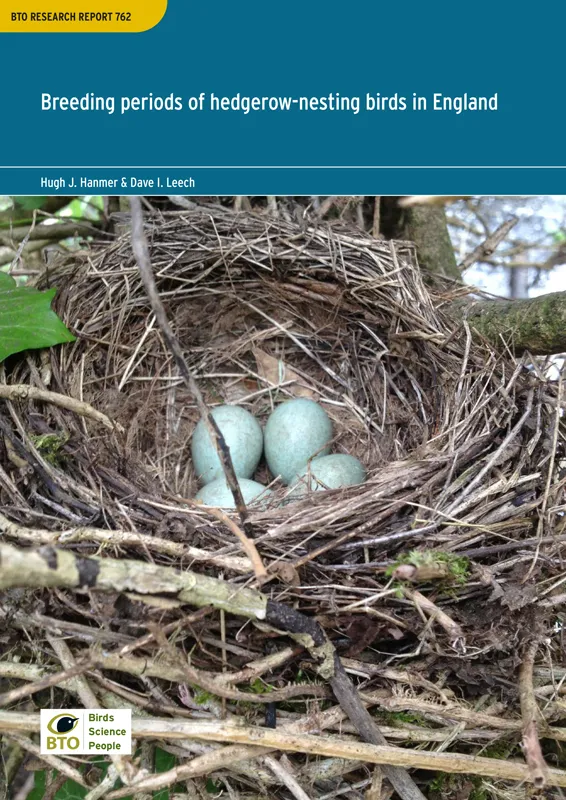
Combining host and vector data informs emergence and potential impact of an Usutu virus outbreak in UK wild birds
Author: Lawson, B., Robinson, R.A., Briscoe, A., Cunningham, A.A., Fooks, A.R., Heaver, J.P., Hernández-Triana, L.M., John, S.K., Johnson, N., Johnston, C., Lean, F.Z.X., Macgregor, S.K., Masters, N., McCracken, F., McElhinney, L.M., Medlock, J.M., Pearce-Kelly, P., Seilern-Moy, K., Spiro, S., Vaux, A.G.C. & Folly, A.J.
Published: 2022
The identification of the Usutu virus in Greater London in the summer of 2020 raises questions about the extent of the incursion and its impacts on wild bird populations.
18.06.22
Papers

Nocturnal flight calling behaviour of thrushes in relation to artificial light at night
Author: Gillings, S. & Scott, C.
Published: 2021
New research from BTO has investigated the effect of artificial light at night on birds, indicating that nocturnal migrants are attracted to more brightly lit areas. Migratory birds face many challenges during their annual movements between breeding and wintering areas. New research from BTO has investigated whether artificial light at night (ALAN) could disrupt movement patterns of migrant species, thereby adding to the pressures they face throughout their lifecycle. Migrating at night is a common migratory strategy. For example, 80% of UK summer migrants move after dark, and 40–150 million birds are estimated to cross the North Sea at night each autumn. Previous studies have shown that nocturnal migrants can be affected by ALAN, which can make them disoriented and cause them to collide with structures such as lighthouses, oil platforms and tall buildings. This problem is particularly associated with skyscrapers in North America, where mass mortality events occur each year. While UK and other European cities tend to have fewer tall buildings, it is important to establish the possible impacts of ALAN on migrant birds on both sides of the Atlantic. This study used passive acoustic monitoring devices deployed in the gardens of local birdwatchers to record the calls of nocturnally migrating thrushes (Redwing, Blackbird and Song Thrush). The selected birdwatchers’ gardens spanned a gradient of nocturnal illumination in Cambridgeshire - from the brightly lit city of Cambridge to the darker surrounding villages and countryside - and recordings were made during peak thrush migration, between late September and mid-November in 2019. The audio recordings were analysed using artificial neural networks, which had been trained to identify calls of the target species and differentiate them from other sources of nighttime noise. The results showed that thrush call rates were up to five times higher over the brightest urban areas than in the darkest villages, suggesting a strong effect of ALAN on these migratory species. Although evidence from other studies, such as those involving radar, indicates that this result can be explained by birds being attracted to brightly lit areas, it is also possible that individual birds call more often than normal in such environments if they are disorientated. This work highlights the need to better understand the effect of ALAN on birds and other wildlife, and also the potential for passive acoustic monitoring in helping to answer ecological questions. Read more about this work in a BOU blog: Are nocturnal migrants attracted to cities?
05.05.21
Papers
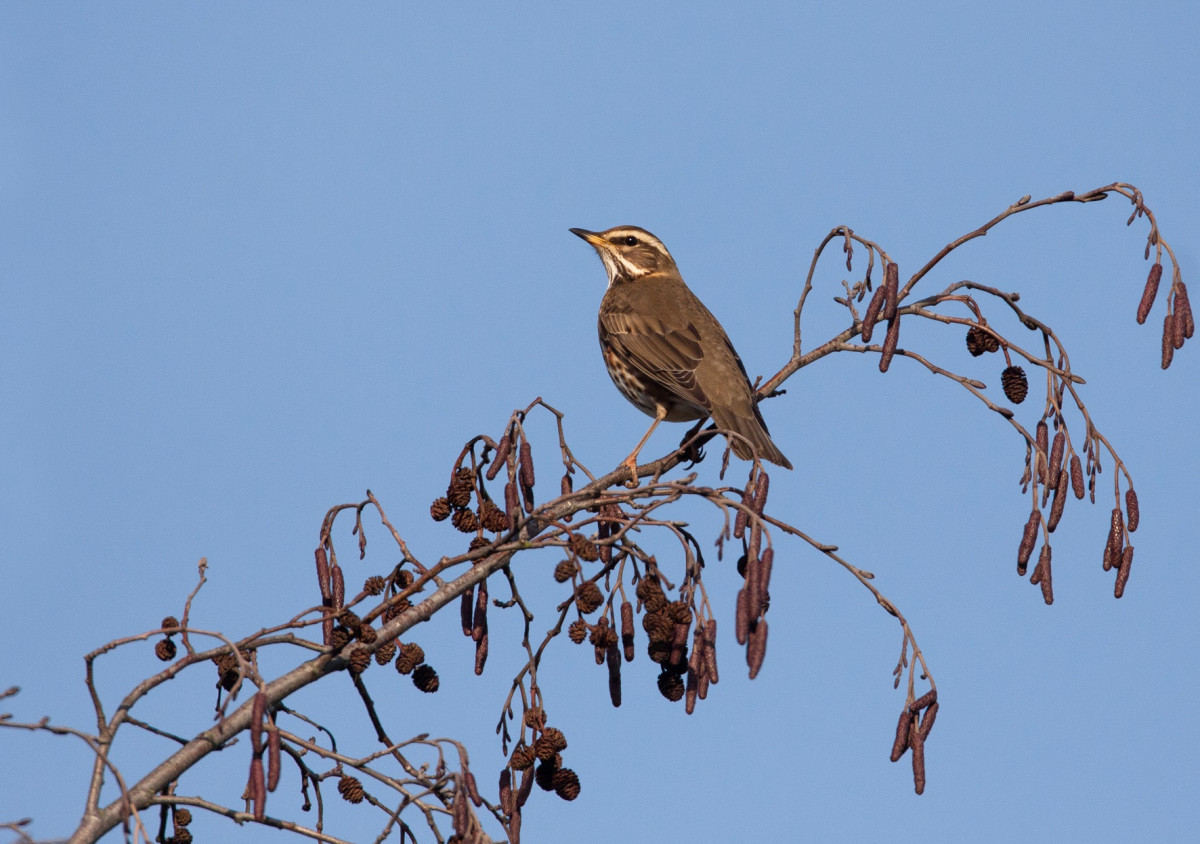
More Evidence
More evidence from Conservation Evidence.com
Partners
Citing BirdFacts
If you wish to cite particular content in this page (e.g. a specific value) it is best to use the original sources as linked in the page. For a more general citation of the whole page please use: BTO (20XX) BirdFacts Species: profiles of birds occurring in the United Kingdom. BTO, Thetford (www.bto.org/birdfacts, accessed on xx/xx/xxxx).

